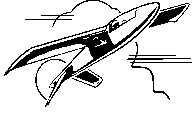









Tail
The Mini-IMP employs an inverted “V”
tail configuration to improve flight performance and simplify construction as
well as reduce weight and cost. This
arrangement also facilitates the use of the tail propeller since the tail of the
aircraft must be high enough off the ground to give adequate propeller clearance
when the aircraft is rotated for either takeoff or landing.
The original wind tunnel tests, radio controlled model tests and computer
studies showed that the inverted “V” tail also contributed greatly to
improved stability, better flight control and maneuverability, and reduced
external noise from the aircraft. The
inverted “V” arrangement imparts a favorable rolling movement to the
aircraft in flight when the rudder is applied, whereas conventional tails or
upright “V” tails cause the aircraft to tend to roll in the opposite
direction from the direction of rudder application.
Further, the relatively low positioning of the inverted tail surfaces
tend to cause the nose of the airplane to raise as the aircraft is rolled, and
this imparts very desirable “spiral stability” into the flight
characteristics. When the Mini-IMP is put in a turn and the controls are
centered, the aircraft will come out of the turn and fly straight and level. In
fact, given sufficient room, the Mini-IMP will return to level flight from
practically any attitude other than being inverted, and recovery from a vertical
turn to level flight requires less than 180 degrees of turn - “HANDS OFF”.
The tail propeller of the Mini-IMP imparts directional and pitch
stability far in excess of what is found in conventional lightplanes, and the
Mini-IMP tend to hold course and altitude (the latter when properly trimmed) far
better than most lightplanes.

All tail control surfaces are
fitted with full piano-type hinges, which assures high strength attachment and
less air leakage through the hinge lines. Flight
control surfaces are also fully balanced to assure minimum danger of flutter and
reduce friction in the control system. The tail surfaces have been static tested to 6 g ultimate (at
1000 pounds gross) without taking permanent “set”.
The tail surfaces of the
Mini-IMP are fully adjustable, so that pitch trim of the aircraft can be easily
accomplished without drag-inducing trim tabs, or force-relieving (also control
displacing) bungee installations. This
arrangement further reduces drag of the aircraft when the flaperons (full span
ailerons) are collectively displaced UP into the “cruise” position, which
produces an attendant nose up trim. This
trim effect is completely eliminated through re-trimming of the tail surfaces in
a “nose down” direction which further reduces down load on the tail with a
resulting reduction in effective wing loading.
This reduction in tail drag also results in further reduction of the
induced drag of the wing resulting in a very efficient cruise configuration.
Tail trim is accomplished by a manual control, which is positioned at the
pilots left side where it is “at hand” without excessive motion of the
pilots left hand. The lift lever is
also positioned adjacent and just above the trim lever along with engine
throttle so that the pilot need not move his arm from the arm rest on the left
side to move any of these three controls.
The 2-element tail not only
provides excellent stability and control, but it also provides suitable
structure below the tail boom, which serves as an adequate bumper to prevent
possible inadvertent striking of the propeller. This is particularly important when handling the unloaded
aircraft such as when pushing it into a hanger or loading it on its trailer.
It is virtually impossible to strike the propeller when flying or with a
pilot sitting in the cockpit. The
2-element tail is also lighter than a 3-element tail and this compensates for
the weight of the propeller and shaft at the rear of the aircraft.
 Mini-IMP
Aircraft Company
Mini-IMP
Aircraft Company 